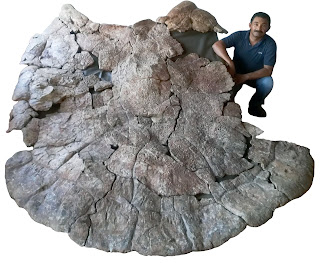These aquatic beasties had shells almost three metres long (up to 9.5 feet) making it about a 100 times larger and sharing mixed traits with some of it's nearest living relatives — the giant South American River Turtle, Podocnemis expansa and Yellow-Spotted Amazon River Turtle, Podocnemis unifilis, the Amazon river turtle, Peltocephalus dumerilianus, and twice that of the largest marine turtle, the leatherback, Dermochelys coriacea.
It was also larger than those huge Archelon turtles that lumbered along during the Late Cretaceous at a whopping 15 feet, just over 4.5 metres. Stupendemys geographicus lived during the Miocene in Venezuela and Columbia. South America is a treasure trove of unique fossil fauna.
Throughout its history, the region has been home to giant rodents and an amazing assortment of crocodylians. It was also home to one of the largest turtles that ever lived. But for many years, the biology and systematics of Stupendemys geographicus remained largely unknown. When we found them in the fossil record it is usually as bits and pieces of shell and bone; exciting finds but not enough for us to see the big picture.
 |
| Palaeontologist Rodolfo Sánchez with Stupendemys geographicus |
But for almost four decades, very few complete carapaces or other telltale fossils of Stupendemys were found in the region.
This excited Edwin Cadena, Paleontologist at the Universidad del Rosario in Colombia and researchers of the University of Zurich (UZH) and fellow researchers from Colombia, Venezuela, and Brazil. They had very good reason to believe that it was just a matter of time before more complete specimens were to be found. The area is a wonderful place to do fieldwork. It's an arid, desert locality without plant or forest coverage we see at other sites. Fossils weather out but do not wash away like they do at other sites.
Their efforts paid off and the fossils are marvellous. Shown here is Venezuelan Palaeontologist Rodolfo Sánchez with a male carapace (showing the horns) of Stupendemys geographical. This is one of the 8 million-year-old specimens from Venezuela.
 |
| Rodolfo Sánchez with Stupendemys geographicus |
Together, they paint a much clearer picture of a large terrestrial turtle that varied its diet and had distinct differences between the males and females in their morphology. Cadena published in February of this year with his colleagues in the journal Science Advances.
The researchers grouped together from multiple sites to help create a better understanding of the biology, lifestyle and phylogenetic position of these gigantic neotropical turtles.
Their paper includes the reporting of the largest carapace ever recovered and argues for a sole giant erymnochelyin taxon, S. geographicus, with extensive geographical distribution in what was the Pebas and Acre systems — pan-Amazonia during the middle Miocene to late Miocene in northern South America).
This turtle was quite the beast with two lance-like horns and battle scars to show it could hold its own with the apex predators of the day.
They also hypothesize that S. geographicus exhibited sexual dimorphism in shell morphology, with horns in males and hornless females. From the carapace length of 2.40 metres, they estimate to total mass of these turtles to be up to 1.145 kg, almost 100 times the size of its closest living relative. The newly found fossil specimens greatly expand the size of these fellows and our understanding of their biology and place in the geologic record.
Their conclusions paint a picture of a single giant turtle species across the northern Neotropics, but with two shell morphotypes, further evidence of sexual dimorphism. These were tuff turtles to prey upon. Bite marks and punctured bones tell us that they faired well from what must have been frequent predatory interactions with large, 30 foot long (over 9 metres) Caimans — big, burly alligatorid crocodilians — that also inhabited the northern Neotropics and shared their roaming grounds. Even with their large size, they were a very tempting snack for these brutes but unrequited as it appears Stupendemys fought, won and lumbered away.
Image Two: Venezuelan Palaeontologist Rodolfo Sánchez and a male carapace of Stupendemys geographicus, from Venezuela, found in 8 million years old deposits. Photo credit: Jorge Carrillo
Image Three: Venezuelan Palaeontologist Rodolfo Sánchez and a male carapace of Stupendemys geographicus, from Venezuela, found in 8 million years old deposits. Photo credit: Edwin Cadena
Reference: E-A. Cadena, T. M. Scheyer, J. D. Carrillo-Briceño, R. Sánchez, O. A Aguilera-Socorro, A. Vanegas, M. Pardo, D. M. Hansen, M. R. Sánchez-Villagra. The anatomy, paleobiology and evolutionary relationships of the largest side-necked extinct turtle. Science Advances. 12 February 2020. DOI: 10.1126/sciadv.aay4593

